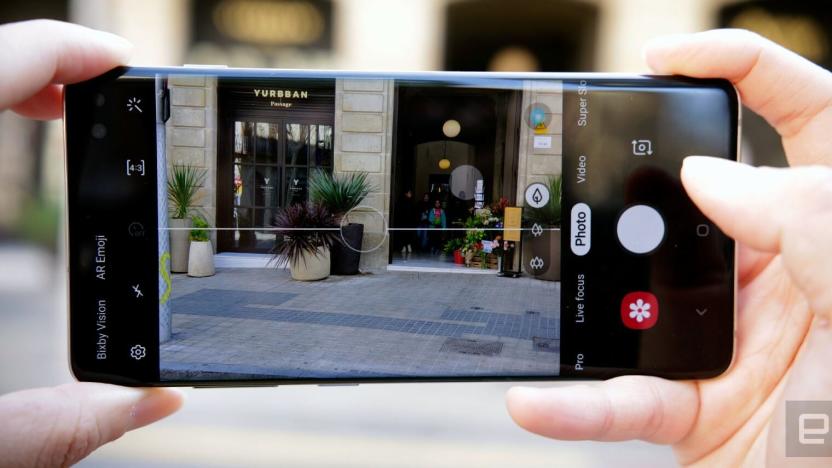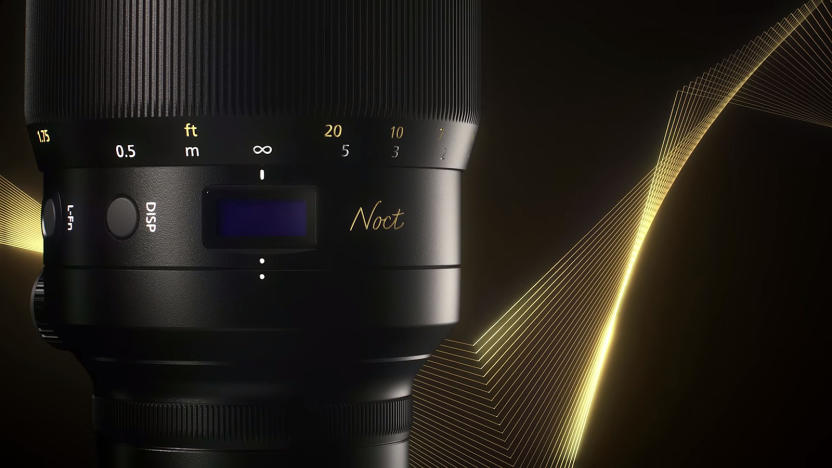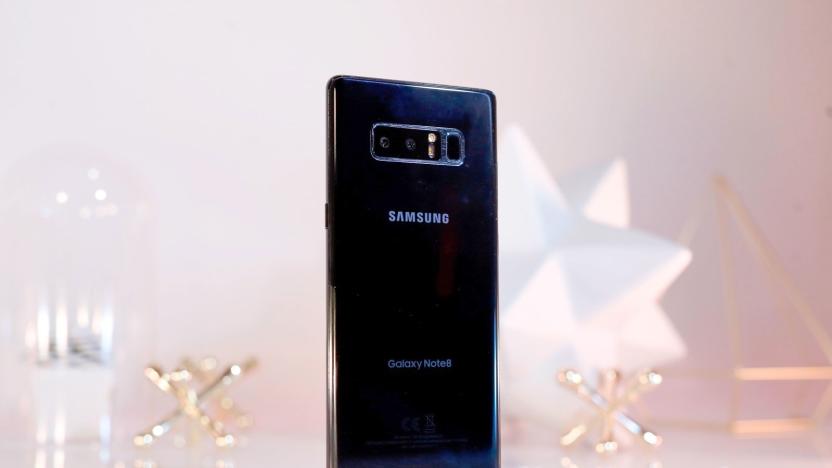LowLight
Latest

Samsung's 108-megapixel mobile sensor closes in on mirrorless cameras
With the smartphone megapixel camera wars raging on, Samsung has fired a significant shot. It unveiled a 108-megapixel smartphone camera sensor that's likely to appear in an incoming Xiaomi Redmi smartphone. The 1/1.33-inch ISOCELL Bright HMX sensor, developed by Samsung in collaboration with Xiaomi, is one of the largest smartphone sensors ever, about three quarter the size of the 1-inch sensor on Sony's RX100 VII. That's just a touch smaller than the sensor Nokia used on its legendary Pureview 808 phone.

Samsung's Galaxy S10 camera gets a dedicated 'Night' mode
Samsung has started rolling out a new feature for the Galaxy S10 camera called "Night" mode, according to SamMobile. It looks like a replacement for the original "Bright Night" feature that activated automatically (and only automatically) to let you take long exposures in very low-light conditions. With Night mode, you can decide when to turn the feature on and off, much as you can on Huawei's P30 Pro or with the Pixel 3's "Night Sight."

Nikon's 58mm f/0.95 'Z-Noct' lens shows why it created the Z-Mount
When you see Nikon's new Z6 and Z7 mirrorless cameras, the first thing that stands out is that massive 55mm lens mount. With the announcement of a new lens (under development), Nikon has shown exactly why it's that large. The manual focus Z-Noct f/0.95 lens will allow for extreme low-light shooting with a razor-thin depth of field. At the same time, Nikon is promising more sharpness than ever for such a fast lens.

Sony unveils world's first 48-megapixel smartphone sensor
Is it best to have a high-resolution smartphone camera or a lower-resolution one with better light sensitivity? Sony says you can have both with its latest stacked CMOS image sensor. The IMX586 has the "industry's highest pixel count" with 48 megapixels, bettering high-end cameras like its own A7R III, all squeezed into a phone-sized 8.0 mm diagonal unit. At the same time, four adjacent pixels can be added together during low light shooting, yielding a 12-megapixel sensor that delivers "bright, low noise images," Sony said.

Samsung's dual camera 'bokeh' tricks are coming to budget phones
Dual-camera smartphones with improved low-light photos and fancy, defocused "bokeh" behind subjects are pretty new and until now, have been reserved for high-end smartphones. Showing how fast things can move nowadays, however, Samung has revealed a new "Isocell dual" camera module for lower-priced mobile phones. With built-in software and algorithms, they specifically allow two features: shooting in dim light, and blurring backgrounds to create "bokeh" after you've taken a photo.

Samsung's latest smartphone camera loves the low light
Are you sick of disappointing low light photos taken on your smartphone? Samsung might have a solution for you. At an investor conference in Korea, the telecommunications brand announced a new camera called BRITECELL that excels in darker conditions. The camera manages to achieve brighter, sharper results by getting rid of the traditional Bayer filter layout used in most smartphone cameras. This is a filter that turns pixels green and blocks light from hitting the sensors, making photos darker. Samsung has traded these green pixels for white ones that allow more light to pour through the lens. More light means brighter photos. Simple, right?

Experimental 3D scanner creates clear images with almost no light
We've seen single-pixel cameras, and now MIT researchers have figured out how to create clear images of dimly-lit objects using single photons -- in 3D, no less. The technique doesn't involve any fancy new hardware, either, as the team worked with a standard photon detector that fired low-intensity visible laser light pulses. The magic happens from the algorithms they developed instead, which can pick out variations in the time it takes for individual photons to bounce off of subjects. After the software separated the noise (as shown above) the result was a high-res image created with about a million photons that would have required several hundred trillion with, say, a smartphone camera. That'll open up new possibilities for low-energy surveying, for instance, or even spy cameras that could virtually see in the dark -- because no laser research project is complete with a sinister-sounding military application.

Graphene camera sensors said to be 1,000 times more sensitive to light
While we're still scratching around with Ultrapixels and OIS, scientists in Singapore claim they're working on something that could change the entire field of photography. Researchers at the Nanyang Technological University have developed an image sensor made out of graphene that's 1,000 times better at capturing light than traditional CMOS or CCD sensors, all while using 10x less energy. These new sensors may initially be used in surveillance equipment and satellites -- when they do eventually end up in regular cameras, however, they're promised to be five times cheaper than the sensors they're replacing. Combine this with the work being done on graphene batteries, and we're that much closer to the perfect smartphone.

Engadget visits Nokia House wrap-up: Stephen Elop Q&A, Lumia 920 camera tests and more
It's been a whirlwind week of all things Nokia for our Engadget crew here in Helsinki, Finland. With a (nearly) all access pass to the company's glass House in Espoo, we brought you a very candid, very live Q&A with CEO Stephen Elop -- recorded for posterity with the Lumia 920 -- as well as in-depth proofs of that handset's game-changing rear camera module. From side-by-side low light comparison shots with other leading smartphones to optical image stabilization tests and even a peek behind the Finnish outfit's R&D practices, we've got it all. So, if you haven't had time to catch up with this flurry of pre-launch news from behind the blue velvet rope, now's your chance. Just click on past the break for the full recap.

Future Panasonic G camera's 72Mbps movie-making prowess teased through speedy drama (video)
If Panasonic didn't have attention from movie producers before, it just might as of this week. Joining the quickly developing tradition of camera makers producing elaborate short movies as technology demos, the company has let cinematographer Philip Bloom wield (and tease) a "brand new G camera" to record Genesis, a fast-paced mini-drama showing a man's race to meet his love before it's too late. While Bloom can't talk much about the hardware in question until the 17th, he's allowed to confirm that the upcoming Micro Four Thirds body relies on a "superb" 72Mbps All-I codec for video -- letting it capture a sprint through the streets without the compression artifacts of the AVCHD format used by most mirrorless cameras. Panasonic's upcoming shooter also touts "much improved" results in the dark, Bloom says. It all sounds very tempting, especially if it turns out that Panasonic's inadvertent leaks are for the same camera we see in action here. The full movie is available after the break, and Bloom has the behind-the-scenes details at the source link.

Nikon D800 studio samples posted at DPReview (update: 5D Mark III studio sample added)
Nikon faced some backlash following the announcement of its D800 DSLR, due both to the camera's potentially excessive 36.3-megapixel resolution and its relatively limited top sensitivity of ISO 25,600. Then, less than one month later, Canon revealed its own mid-range full-frame cam -- the 5D Mark III -- with a 22.3-megapixel sensor, and an option to shoot at ISO 102,400. Both models appeal to the same market of professional photographers, but with vastly different specs, which is the better pick? Low-light shooters will likely base part of that decision on high-ISO capabilities, and after reviewing samples from both cameras, there appears to be a winner.DPReview spent some time with the D800, and we took the Canon for a spin last week. We scaled the D800 sample down to 22.3 megapixels to match the 5D, then pasted a 300-by-400 1:1 pixel section from each camera side-by-side in the image above. The D800 JPEG (on the left) appears to be the noisier of the two, which seems logical, considering that Nikon opted to boost the camera's resolution instead of its sensitivity. Still, the cam's top-ISO is quite usable, and if you plan to shoot in a studio setting or can live without a six-digit sensitivity, the D800 will likely suit you just fine. Hit up our source link for samples shot at the full ISO range, including full-res downloads, to make that call for yourself.Update: We've replaced the Canon sample with a studio shot from DPReview, which provides a more accurate comparison. You can find images from both cameras at our source links below.

Canon's 8-inch CMOS sensor can record SPACE at 60fps
For whatever reason, Canon seemed more concerned with showing off its engineering prowess than finding a use for the giant 8-inch CMOS sensor it created last year. Fortunately, the super-powerful snapper has found its way into the 105-centimeter Schmidt Telescope at the University of Tokyo's Kiso Observatory. The sensor's size makes it a perfect fit to record in low-light; capturing the wonders of the universe in 0.3 lux at 60 fps. The University will premiere footage from the experiment, possibly with nibbles, after September 19th -- presumably in a theater with a blanket ban on people muttering the introduction to Star Trek as it plays.

AIST shows off full-color night vision camera, well lit Bullwinkle figurine (video)
You might know them for seemingly ridiculous innovations like Segway shoes or the HRP-4C pop star robot, but the folks at AIST have put away the gimmicks for their latest invention -- a full-color night vision camera. Produced by Nanolux, an arm of AIST, the camera uses a series of algorithms to read and process wavelengths reflected by objects lit with infrareds, allowing it to successfully reproduce reds, blues, and greens in the darkest of conditions. The company hopes to make the device available by the end of 2011 at a price point lower than conventional night vision cameras, and says they will work with different lenses to improve long-range photography for the device. Such an invention could have serious implications for fields like surveillance and wildlife observation, but fear not, AIST hasn't lost its sense of humor -- the company used a Bullwinkle figurine rotating on a Lazy Susan to demo its latest invention at Printable Electronics 2011. Check out the video after the jump.

Nikon D7000 firmware update released, cools down 'hot pixels'
Hot on the heels of its P7000 firmware update, Nikon has just released one for its D7000 DSLR as well. The update was created for the sole purpose of fixing the hot pixel issue that pops up when taking videos in low light. While this doesn't completely eliminate the problem, the "bright spots" effect has been "reduced" according to Nikon USA. Unfortunately, this means you no longer have an excuse to not record your child's rendition of The Best Christmas Pageant Ever. Hit up the source link for the download.

Canon develops world's largest CMOS sensor, shoots 60fps video in moonlight
Did you ever think that you'd see a CMOS sensor measuring 202 x 205 mm? That's 7.95 x 8.07 inches to our fine imperial friends. Its impressive size -- about 40 times larger than Canon's largest commercial CMOS sensor -- translates to staggering light-gathering capabilities, capturing images in one one-hundredth the amount of light required by a professional DSLR. Better yet, the sensor is matched by new circuitry allowing for video capture at 60fps in just 0.3 lux of illumination (think full moon on a clear night). Unfortunately, the press release is more concerned with promoting Canon's engineering prowess than with product launch. Nevertheless, we're impressed.

Shooting around with the Nikon D3S: the field review
Nikon's D3S didn't exactly emerge out of nowhere, but the DSLR's boosted ISO ceiling of over 100,000 (102,400, if we're being precise) has certainly shaken up the industry. Nikon claims that it's set a new bar for low-light performance and raw speed in the crowded DSLR arena, and we were tickled pink when given the chance to see if this thing was worth its weight in gold. Now, the master photogs over at DP Review have already broken down the nitty-gritty details in an exhaustive 34 page critique, but for those just looking for a little insight -- and perhaps a short answer to "should I buy this?" -- we've got exactly what you're looking for. Head on past the break for two distinct takes on Nikon's most capable shooter yet -- and some thoughts on how Nikon's latest monster professional cam will radically change the consumer camera as well.

South Korean image-sensing chip enables 1-lux photography
Taking photos and videos in low-light situations has always involved some kind of tradeoff: you can either crank up the ISO and reduce image quality significantly, use something like Sony's NightShot and add that alien green tint to everything, or trust your image stabilizer to go from wacky-blurry to just pretty-blurry. That might be about to change, though, as South Korea's state-owned Korea Electronics Technology Institute has announced a new image sensor chip that promises to take "vibrant photos" in extreme low-light conditions -- all the way down to 1 lux, which is the equivalent light output of a candle shining one meter away. Details are scarce, but the "single carrier modulation photo detector" chip is said to use some amount of nanotechnology and reportedly cost $10.5 million to develop. We haven't heard when the chip might hit the market, but the Korean government is expecting to make 2 trillion won ($2.1 billion) a year exporting this little guy in the future. We'd put our money on the home team, of course -- expect to see Samsung or LG release no-light cameras before the rest of the pack.









